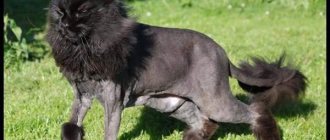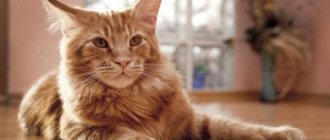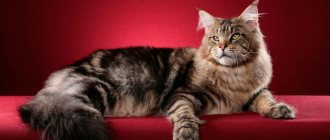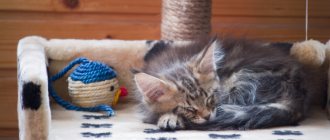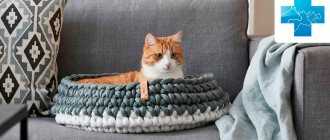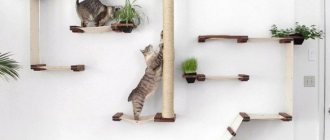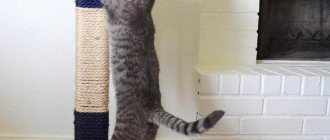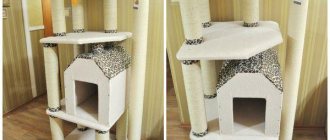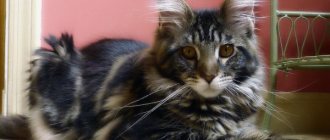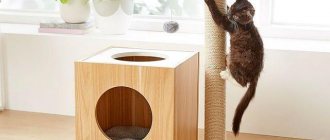A scratching post is one of the mandatory attributes of any home where a cat lives. In most cases, we do not take its choice too seriously, as a result of which the pet simply ignores the purchase and uses upholstered furniture to sharpen its claws. Any veterinarian will tell you that this approach is fundamentally wrong and certain rules must be followed, especially when it comes to the Maine Coon.
Why does a Maine Coon need a scratching post?
A scratching post is vital for a Maine Coon, because too long claws prevent him from walking and standing on his paws calmly and even cause pain, not to mention the danger of catching a fungus or infection, which will lead to delamination, peeling, etc.
The Maine Coon is an animal with human psychology. He considers himself not a cat, but a full-fledged member of the family who must be taken into account. That is why he uses the scratching post not only for its intended purpose, but also as a tool for communication with household members. The Maine Coon needs constant control over what is happening in the apartment and a demonstration of its, if not superior, position, then at least equal. His requirements for the scratching post are as follows:
- it should be high enough to rise above the general level of the furniture for a wide view
- it should be installed in the most accessible place in the home, where people most often pass by (for example, in the living room combined with the kitchen, in the hallway or next to the toilet)
- the base must be very stable, because the Maine Coon has quite significant dimensions
Important! The recommended height of the scratching post is 100 cm. It does not provide such a large view of the room, so it is advisable to have such a design on a cabinet or other elevation.
A house is not necessary for the Maine Coon because it is a very social cat breed. A cat with a healthy psyche will never want to hide; on the contrary, he loves to be the center of attention, to lie in the most visible place so that everyone is looking at him. For this reason, a bed is a must. It must be at least 75 cm in length and 45 cm in width.
Attention! The design should include a small step between the bed and the base so that the cat does not injure its joints when making high jumps.
Required materials and tools
A cat's sense of smell is much more subtle and sensitive than a human's. Therefore, when making such an important and necessary attribute of a cat’s life as a scratching post, you need to use only natural materials that do not have a pronounced odor. Yes, this would be perfect:
- tree;
- jute, linen or sisal ropes;
- leg-split;
- sackcloth;
- hemp;
- pressed or corrugated cardboard;
- carpet
But artificial materials can cause allergies and cause serious harm to the cat’s health. For example, you should not make a scratching post from a plastic pipe - plastic has an unpleasant odor and is allergenic.
Another important advantage of products made from natural fibers is that they remove static electricity well.
The surface of the scratching post should be made rough and durable, but not too hard. The process of scratching should give the cat pleasure and relax it, and not bring unpleasant, and even more so, painful sensations to the animal, and cause broken claws.
The cat's claws should penetrate several millimeters deep into the fabric, tearing the fibers of which it is composed, but without clinging to them. From this point of view, the best solution is sisal rope.
- Try not to use nails and metal staples to connect the parts of the nail clipper, or fix them tightly and thoroughly so that your pet does not get hurt when cleaning its claws. It is advisable to place the fastening parts on the reverse side of the product.
- The material for the scratching post also depends on the size of the animal. If the cat is small, then it is better to give preference to models made of cardboard or corrugated cardboard - if the coating is too hard, the baby can damage its claws.
- However, large representatives of the cat family have stronger and harder claws, so it is worth making cloth for them from stronger and more durable materials. For a large cat, natural wood is suitable.
Only it is better to choose a tree that does not smell strongly and without knots, having first cleared it of bark.
And, of course, be guided by the tastes of your cat. Look at what your pet is sharpening its claws on now. Try to use the same or similar material when making homemade scratches. If he prefers doors, then a piece of wood will do.
If he “does a manicure” on rugs, then carpet will be the best choice; scratches the furniture upholstery - choose jute or sisal rope for covering (the latter is the most reliable and durable material, although the most expensive).
To create a scratching post you may need the following tools:
- threads;
- glue;
- scotch;
- compass;
- screws;
- stapler;
- stationery knife;
- drill;
- hammer and others.
Each model will have its own set of tools.
How to make a scratching post house for a large Maine Coon with your own hands
There are several ways to make a scratching post for a Maine Coon with your own hands; the diagram and dimensions for each method will be different. For this reason, it is better to decide in advance which complex you want to give preference to. For this breed, you should choose between the largest models: high play houses with a podium, posts, wall-mounted scratching posts, etc.
Reference! We should probably only abandon floor structures. Such scratching posts are simply not suitable for large Maine Coons, because due to the large weight, the cat can simply turn it over with its paw (or it will not be long enough to stretch out on it).
Manufacturing materials
A scratching post for a Maine Coon can even be made from scrap materials, because the necessary “consumables” very often remain on the farm after construction or repairs. Even if there are no such stocks in the pantry, it will not be difficult to buy them, because they are available in any hardware store or market. You may need:
- jute rope or twine rope (10-20 meters or more, colors of your choice)
- carpet
- corrugated cardboard
- natural fabric (preferably at least 1-2 m)
- dense board (length from 1.2 m, width 20 cm, thickness up to 2-3 cm)
- square beam up to 1.2 m high and up to 20 cm thick or a pipe with a similar diameter made of any material
Selecting size and shape
Regarding the size of the scratching post, there are certain standards in this regard: the larger the pet, the larger the scraper should be. The parameters of the product directly depend on the size of the cat. This is especially important for wall models, so that the cat does not scratch the wallpaper while sharpening its claws.
The width of the claw blade in this case should be equal to the width of the animal’s outstretched paws. You can calculate the length of the scratching post by adding 5-10 cm to the length of the cat itself (excluding the tail).
For Maine Coons, the height of the vertical nail bed should not exceed 100 cm, especially if there is a bed on top. This is necessary in order to remove excess load from the front paws when jumping. For a kitten, make a scratching post “for growth”, focusing on its approximate future size as an adult.
If the living space allows, then it is better to supplement the nail sharpener with a bed and a house, one or more.
The variety of scratching post models is simply amazing. There are 2 main types of scratchers: floor and wall (or hanging). There are many variations within each type. Thus, floor scratching posts can be flat (located horizontally or at an angle), in the shape of a column, equipped with additional beds, stairs, bridges and houses.
The more cats there are in the house, the more elements the scratcher should consist of.
And almost all designs can be made with your own hands from available materials. The main thing is your desire and willingness to spend a certain amount of time on your pet.
How to train a Maine Coon to use a scratching post
Accustoming a Maine Coon to a scratching post should be as comfortable as possible from a psychological point of view. You need to let the cat know that you encourage this action and arouse his maximum interest. For example, you need:
- Hang a toy on a scratching post (mouse, ball on a string, feather, etc.)
- pet and praise the cat when he tries to use the scratching post
- try to independently bring him to the scratching post, hang him on it by his paws so that he understands the meaning of the device
Wall-mounted plywood scratching post
Looking at photos of hand-made scratching posts, we can see this option. This design is very easy to make.
It is only important to calculate the dimensions correctly. It is better if the scratching post is 10-15 centimeters larger than the cat’s height. This will protect the walls from scratches. In terms of width, it is better that the surface is at least 40 centimeters.
- You will need to prepare two plywood sheets with a width of 25 centimeters (for large cats, these parameters naturally increase). For a soft layer, a piece of old carpet will do - you will need to secure it to the plywood with the wrong side up. The piece is fixed using a stapler.
You can also wrap the sheet with a rope and secure it with slats along the edges. Next, the structure is nailed to the wall. All that remains is to train the cat to use the device.
Basic rules for reliable installation
An important requirement for any scratching post is its correct fastening. A scratching post with your own hands must support the weight of the cat, and not tip over, and have a stable base. If the fastening is weak, the animal will be able to knock it over, this may lead to the fact that the pet will begin to be afraid of it and after this incident will not use it.
The base must be calculated taking into account the height and body weight of the animal.
There are a few tricks to getting your cat to like this new piece of furniture. To do this, it is recommended to treat the jute rope for the scratching post with mint or catnip leaves. It should not be treated with valerian.
Most cats prefer to sharpen their claws in the morning, so it is better to place it near their sleeping place (ideally, make a bed or house equipped with a post with a jute winding). If possible, it is recommended to place a new scratching post in those places where the cat was accustomed to sharpening its claws before its appearance.
To make it clear how to make a scratching post on your own at home, you can watch a video of making a scratching post.
Quick option
It happens that a cat appears in the house unexpectedly, or you are given an animal for a while (for example, the owners go on vacation).
In this situation, a DIY scratching post house is an additional waste of time. You can make the construction faster:
- A softwood log is an excellent alternative to the store-bought version. Its length can be about 70-100 meters. We chop the log lengthwise and attach a piece to the wall.
- You can take packaging cardboard and roll it up. We secure it with rope in several places and attach it to one of the walls.
- An old carpet or bedding can be rolled up with the inside out - it will be convenient for your cat to sharpen its claws on this surface.
Where to place the scratching post
For a Maine Coon, it is important that his playhouse is located in a room where someone from the family is always present. The ideal place would be a corner of the living room that offers the best view.
An excellent option would also be 2-3 models located in different rooms. Moreover, it is better to make them different. However, it is better to place the largest one in the place where your pet spends the most time, or where he is most likely to want to play. This will save your furniture and make your Maine Coon happy.
Other useful accessories
A simple design will contain only two elements - a Maine Coon house and a scratching post. If desired, this modest set can be supplemented with new items.
- Add another round or rectangular stand braided with cord.
- Shelves are made between two claw masts.
- Cats are very fond of hammocks, which are stretched over the supports of the structure.
- They arrange transition ladders or connecting slats that resemble a narrow cornice.
All additional attributes must be covered with fabric, and when using a pipe or timber, they must be wrapped in rope braiding.
What are the types
All cat furniture can be classified according to various criteria, affecting comfort, purpose, and other features. Options for scratching posts are distinguished by types, sizes, shapes and purposes. Depending on the type, the methods of fastening vary.
By size and shape
These are the two main criteria that influence the price of the product and what breed it is suitable for. There are some options for scratching posts.
Scratching post post. The pole itself is trimmed with fabric, twine, and thick rope. It is attached to a base, which can be round, square, or rectangular.- Pipe with an upper shelf-bed. This design has a wider base and a special shelf on top where you can sleep or lie down. The height of such a scratching post does not exceed one meter. The model with a shelf is suitable for medium-sized animals.
- With a house. In the lower part there is a kind of kennel in which the cat can spend its free time, and above it there is a scratching post in the form of a column.
- In the form of a pillow. In this case, a pillow with a flat surface is placed on a solid base, and next to it is a post for caring for claws. Many cats like to lie on such “sofas” so that they can see what is happening around them.
- Two-story structure. In this case, two houses are located on top of each other, connected by a manhole or board to move from one to the other.
- With a shelf. A special option is a complex design with a shelf, possibly none and several tiers. Some models may consist of three or more tiers located on top of each other.
Question to an expert
How to choose the right house for a cat? What should you pay attention to?
Any house, regardless of the complexity of its structure, must be suitable in size. Furniture for a Maine Coon is different from a house for, for example, a medium-sized cat. For large cats, special models are produced that can withstand their weight and match their size.
Interesting read: everything about Maine Coon cats.
By type of fastening
Scratching posts are also divided according to the method of their attachment. There are three main types:
- Floor scratching post. This is the most common type. This is a post scratching post with sisal rope with a base. The height should correspond to the size of the cat itself. This option has one drawback - it can move around the apartment when used, since it is not attached to the floor or wall.
- Wall-mounted scratching post. This design takes up more space, they are usually hung at the height of the cat, or can be hung on a screw or nail.
- Corner scratching post. It can be either floor or hanging, but due to its geometry, it fits into the corner of the room.
- Road model. Such devices will come in handy if you have a long trip ahead.
The place must be chosen according to the preferences of the cat itself, while ensuring that it does not disturb people.
By type of materials
Depending on whether the product was purchased in a store or made by hand, the type of materials the scratching post can be as follows:
- made of wood;
- from table legs;
- made of wood.
A scratching post made of corrugated cardboard is also available, but this option has a limited service life; it is better to choose plywood or chipboard. A cardboard scratching post will not last long, and when used it will generate a lot of debris in the form of torn pieces.
The most popular models of scratching posts
The rating of the best forms and models is headed by floor products.
Such devices can be made in the form of a rug or board. Sisal, jute, and medium-diameter rope are used as upholstery. This option is the simplest, most common and budget-friendly, for example, a custom-made scratching post with a house. The second most common are wall-mounted models with the following advantages:
- compactness;
- wall mounting;
- reliability;
- cheapness.
Most buyers of such models are satisfied with their choice. In stores you can find designer scratching posts that are produced according to exclusive projects. The main disadvantage of such products is their high cost.

